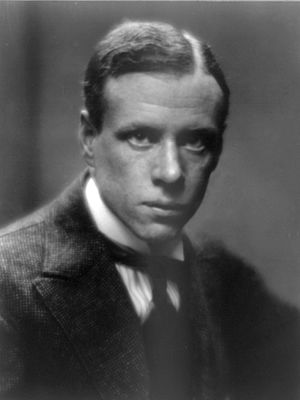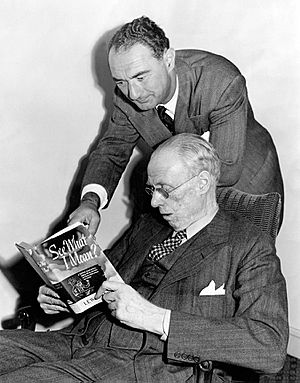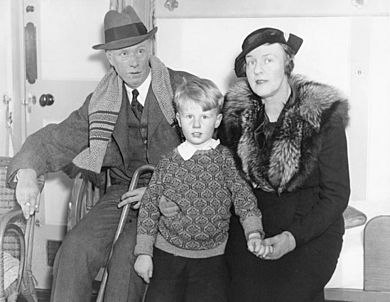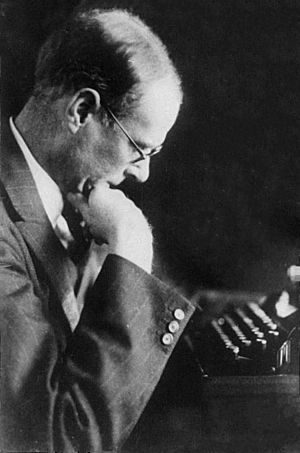Sinclair Lewis facts for kids
Quick facts for kids
Sinclair Lewis
|
|
|---|---|

Lewis in 1930
|
|
| Born | Harry Sinclair Lewis February 7, 1885 Sauk Centre, Minnesota, United States |
| Died | January 10, 1951 (aged 65) Rome, Italy |
| Occupation | |
| Alma mater | Yale University |
| Notable works | Main Street Babbitt Arrowsmith It Can't Happen Here |
| Notable awards | Nobel Prize in Literature 1930 |
| Spouse | Grace Livingston Hegger (1914–1925) (divorced) Dorothy Thompson (1928–1942) (divorced) |
| Children | 2 |
| Signature | |
Harry Sinclair Lewis (born February 7, 1885 – died January 10, 1951) was an American writer and playwright. In 1930, he made history. He became the first writer from the United States to win the Nobel Prize in Literature. This award recognized his "strong and clear way of describing things." It also praised his ability to create "new types of characters" with humor.
Lewis is famous for his novels. These include Main Street (1920), Babbitt (1922), and Arrowsmith (1925). Other well-known books are Elmer Gantry (1927), Dodsworth (1929), and It Can't Happen Here (1935).
His books often looked closely at American society. They showed his thoughts on how money and possessions were becoming very important. This was especially true between the two World Wars. He was also admired for creating strong female characters. The writer H. L. Mencken once called him a "red-haired tornado."
Contents
Growing Up in Minnesota

Sinclair Lewis was born on February 7, 1885. His hometown was Sauk Centre, Minnesota. He loved reading books from a young age. He also kept a diary. He had two older brothers, Fred and Claude.
His father, Edwin J. Lewis, was a doctor. He was very strict. It was hard for him to connect with young Sinclair. Sinclair was sensitive and not very athletic. His mother, Emma Kermott Lewis, passed away in 1891. The next year, his father married Isabel Warner. Sinclair seemed to enjoy her company.
Sinclair had a lonely childhood. He was tall, thin, and had acne. He also had somewhat bulging eyes. He found it hard to make friends. When he was 13, he tried to run away. He wanted to be a drummer boy in the Spanish–American War. But he was not successful.
In 1902, Lewis went to Oberlin Academy for a year. This helped him get into Yale University. He started at Yale in 1903. But he didn't finish his degree until 1908. He took time off to work and travel. He worked at Helicon Home Colony. This was a community started by writer Upton Sinclair in New Jersey. He also traveled to Panama.
Sinclair's looks and country manners made it hard for him to fit in. But some students and teachers at Yale saw his writing talent. He made a few lasting friendships there. Later in life, he became an atheist.
Starting His Writing Career
Lewis's first creative writings were poems and short stories. They appeared in magazines at Yale. After college, Lewis moved around a lot. He took different jobs to earn money. He kept writing fiction to fight boredom.
He worked for newspapers and publishing companies. He also spent time at a writers' colony in Carmel-by-the-Sea, California. He became good at writing popular stories. Many magazines bought his work. He also sold story ideas to famous writer Jack London. One of these was for London's unfinished novel, The Assassination Bureau, Ltd.
Lewis's first published book was Hike and the Aeroplane in 1912. It was an adventure story for young readers. He used the pen name Tom Graham for this book.
His first serious novel was Our Mr. Wrenn: The Romantic Adventures of a Gentle Man (1914). After that came The Trail of the Hawk (1915) and The Job (1917). He also published The Innocents: A Story for Lovers in 1917. This was a longer version of a story that appeared in a magazine. Free Air (1919) was another story that first appeared in a magazine.
Becoming a Famous Author
When Lewis moved to Washington, D.C., he focused on writing. By 1916, he was already planning a realistic novel. This book would be about life in a small town. He finished Main Street in mid-1920. It was published on October 23, 1920.
The book was a huge success. One writer called it "the most sensational event" in American publishing. Lewis's agent thought it might sell 25,000 copies. But in just six months, Main Street sold 180,000 copies. Within a few years, it sold about two million. This book made Lewis very wealthy.

Lewis followed this success with Babbitt (1922). This novel made fun of American business culture. It also poked fun at people who always promoted their towns. The story was set in the made-up town of Zenith. Lewis used this town in other novels too. These include Arrowsmith and Dodsworth.
Lewis continued to be successful in the 1920s. He wrote Arrowsmith (1925). This novel was about an idealist doctor and his struggles. It won the Pulitzer Prize. However, Lewis turned down the award. He was still upset that Main Street had not won it earlier. Arrowsmith was made into a Hollywood film in 1931. It was nominated for four Academy Awards.
Next, Lewis published Elmer Gantry (1927). This book showed an evangelical minister as a hypocrite. Many religious leaders criticized the novel. It was even banned in some U.S. cities. Years later, it became a movie in 1960. The film's star, Burt Lancaster, won an Oscar for his role.
Lewis's next book was Dodsworth (1929). This novel looked at wealthy Americans. He showed them as living lives without much purpose. This was true even with all their money. The book was made into a Broadway play in 1934. It also became a successful film in 1936. The film is still highly praised today. In 1990, it was chosen for the National Film Registry.
During the late 1920s and 1930s, Lewis wrote many short stories. One famous story was "Little Bear Bongo" (1930). It was about a bear cub who wanted to leave the circus. He wanted to find a better life in the real world. Walt Disney Pictures later used this story. It became part of their movie Fun and Fancy Free (1947).
Winning the Nobel Prize
In 1930, Sinclair Lewis won the Nobel Prize in Literature. He was the first American writer to receive this honor. The Swedish Academy, which gives the award, especially noted his novel Babbitt.
In his Nobel speech, Lewis praised other American writers. He mentioned Theodore Dreiser, Willa Cather, and Ernest Hemingway. But he also spoke about problems in American literature. He said that many Americans were "afraid of any literature which is not a glorification of everything American." He also criticized American professors. He said they liked their literature "clear and cold and pure and very dead."
Later Years and New Works
After winning the Nobel Prize, Lewis wrote eleven more novels. Ten of them were published during his lifetime. The most remembered is It Can't Happen Here (1935). This novel was about a fascist leader being elected president in America.
In 1931, Lewis had a public argument with writer Theodore Dreiser. Lewis accused Dreiser of copying his wife's work. This led to a physical fight between them. Dreiser hit Lewis several times. The argument also involved competition for the Nobel Prize. Dreiser claimed Lewis's novel Arrowsmith was not original. The feud lasted for months. However, in 1944, Lewis tried to get Dreiser recognized by the American Academy of Arts and Letters.
In the 1940s, Lewis sometimes gave lectures. He often appeared with author Lewis Browne. They toured the United States. They debated topics like "Has the Modern Woman Made Good?" and "Can Fascism Happen Here?". They were known for their lively discussions.
In the early 1940s, Lewis lived in Duluth, Minnesota. There, he wrote Kingsblood Royal (1947). This novel was set in a fictional Minnesota city. It was based on a real court case in Detroit. An African-American doctor was not allowed to buy a house in a "white" area. Lewis's book was an important early contribution to the civil rights movement.
In 1943, Lewis went to Hollywood. He worked on a movie script called Storm In the West. It was a Western movie. But it was also a hidden story about World War II. The bad guys in the script were like Adolf Hitler and his helpers. Movie studio leaders thought it was too political. So, the film was never made. The script was finally published in 1963.
Lewis often visited Williamstown, Massachusetts. In 1946, he rented a farm there. While writing Kingsblood Royal, he bought this summer home. He improved the large house and other buildings. By 1948, he owned a large farm. But his health problems meant he could not live there for long.
Family Life
In 1914, Lewis married Grace Livingston Hegger. She was an editor at Vogue magazine. They had one son, Wells Lewis (1917–1944). He was named after the British author H. G. Wells. Wells Lewis became a U.S. Army lieutenant. He was killed in action during World War II in France.
Lewis and Grace divorced in 1925. In 1928, he married Dorothy Thompson. She was a political newspaper writer. They bought a second home in Vermont. They had a son named Michael Lewis (1930–1975). Michael later became a stage actor. Lewis and Dorothy's marriage ended by 1937. They divorced in 1942.
Sinclair Lewis passed away in Rome, Italy, on January 10, 1951. He was 65 years old. His body was cremated. His ashes were buried in Greenwood Cemetery in Sauk Centre, Minnesota. His last novel, World So Wide (1951), was published after his death.
His Lasting Impact
After his death, Lewis's popularity among literary experts went down. Even though he was very famous in the 1920s, other writers became more well-known. These included F. Scott Fitzgerald and Ernest Hemingway.
However, since the 2010s, people have become interested in Lewis's work again. His 1935 novel It Can't Happen Here is especially popular. After the 2016 United States presidential election, this book became a bestseller on Amazon. Experts have found surprising similarities in his novels to current events. These include the COVID-19 pandemic and the rise of Donald Trump.
The U.S. Postal Service has honored him. They issued a postage stamp in his honor.
Works
Novels
- 1912: Hike and the Aeroplane (for young readers, as Tom Graham)
- 1914: Our Mr. Wrenn: The Romantic Adventures of a Gentle Man
- 1915: The Trail of the Hawk: A Comedy of the Seriousness of Life
- 1917: The Job
- 1917: The Innocents: A Story for Lovers
- 1919: Free Air
- 1920: Main Street
- 1922: Babbitt
- 1925: Arrowsmith
- 1926: Mantrap
- 1927: Elmer Gantry
- 1928: The Man Who Knew Coolidge
- 1929: Dodsworth
- 1933: Ann Vickers
- 1934: Work of Art
- 1935: It Can't Happen Here
- 1938: The Prodigal Parents
- 1940: Bethel Merriday
- 1943: Gideon Planish
- 1945: Cass Timberlane: A Novel of Husbands and Wives
- 1947: Kingsblood Royal
- 1949: The God-Seeker
- 1951: World So Wide (published after his death)
Short Stories
- 1907: "That Passage in Isaiah"
- 1907: "Art and the Woman"
- 1911: "The Way to Rome"
- 1915: "Commutation: $9.17"
- 1915: "The Other Side of the House"
- 1916: "If I Were Boss"
- 1916: "I'm a Stranger Here Myself"
- 1916: "He Loved His Country"
- 1916: "Honestly If Possible"
- 1917: "Twenty-Four Hours in June"
- 1917: "The Innocents"
- 1917: "A Story with a Happy Ending"
- 1917: "Hobohemia"
- 1917: "The Ghost Patrol" (later a silent film in 1923)
- 1917: "Young Man Axelbrod"
- 1917: "A Woman by Candlelight"
- 1917: "The Whisperer"
- 1917: "The Hidden People"
- 1917: "Joy-Joy"
- 1918: "A Rose for Little Eva"
- 1918: "Slip It to 'Em"
- 1918: "An Invitation to Tea"
- 1918: "The Shadowy Glass"
- 1918: "The Willow Walk"
- 1918: "Getting His Bit"
- 1918: "The Swept Hearth"
- 1918: "Jazz"
- 1918: "Gladvertising"
- 1919: "Moths in the Arc Light"
- 1919: "The Shrinking Violet"
- 1919: "Things"
- 1919: "The Cat of the Stars"
- 1919: "The Watcher Across the Road"
- 1919: "Speed"
- 1919: "The Shrimp-Colored Blouse"
- 1919: "The Enchanted Hour"
- 1919: "Danger—Run Slow"
- 1919: "Bronze Bars"
- 1920: "Habaes Corpus"
- 1920: "Way I See It"
- 1920: "The Good Sport"
- 1921: "A Matter of Business"
- 1921: "Number Seven to Sagapoose"
- 1921: "The Post-Mortem Murder"
- 1923: "The Hack Driver"
- 1929: "He Had a Brother"
- 1929: "There Was a Prince"
- 1929: "Elizabeth, Kitty and Jane"
- 1929: "Dear Editor"
- 1929: "What a Man!"
- 1929: "Keep Out of the Kitchen"
- 1929: "A Letter from the Queen"
- 1930: "Youth"
- 1930: "Noble Experiment"
- 1930: "Little Bear Bongo" (later part of the animated film Fun and Fancy Free)
- 1930: "Go East, Young Man"
- 1931: "Let's Play King"
- 1931: "Pajamas"
- 1931: "Ring Around a Rosy"
- 1931: "City of Mercy"
- 1931: "Land"
- 1931: "Dollar Chasers"
- 1935: "The Hippocratic Oath"
- 1935: "Proper Gander"
- 1935: "Onward, Sons of Ingersoll!"
- 1936: "From the Queen"
- 1941: "The Man Who Cheated Time"
- 1941: "Manhattan Madness"
- 1941: "They Had Magic Then!"
- 1943: "All Wives Are Angels"
- 1943: "Nobody to Write About"
- 1943: "Green Eyes—A Handbook of Jealousy"
- 1943: Harri (novella)
Plays
- 1919: Hobohemia
- 1934: Jayhawker: A Play in Three Acts (with Lloyd Lewis)
- 1936: It Can't Happen Here (with John C. Moffitt)
- 1938: Angela Is Twenty-Two (with Fay Wray) (later a film in 1944)
Screenplay
- 1943: Storm In the West (with Dore Schary – never produced)
Poems
- 1907: "The Ultra-Modern"
- 1907: "Dim Hours of Dusk"
- 1907: "Disillusion"
- 1909: "Summer in Winter"
- 1912: "A Canticle of Great Lovers"
See also
 In Spanish: Sinclair Lewis para niños
In Spanish: Sinclair Lewis para niños





